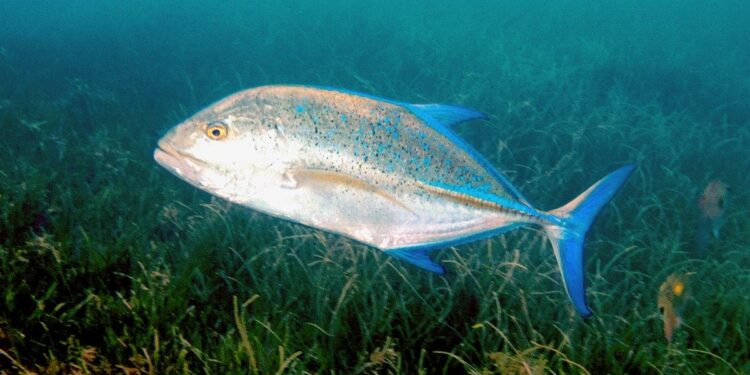In a surprising twist of marine survival strategy, a recent study published in Ecology reveals how carangid fish are taking cover behind sharks to stealthily hunt their prey. Conducted by researcher Cattano and slated for 2025 release, the investigation uncovers this clever form of camouflage and cooperation in the ocean’s complex food web. By exploiting the intimidating presence of sharks, carangids reduce their own visibility to unsuspecting prey, demonstrating an intricate behavioral adaptation that challenges our understanding of predator-prey dynamics beneath the waves.
Carangid Fish Employ Shark Shadows to Enhance Hunting Success
In a striking example of behavioral adaptation, carangid fish have been observed strategically positioning themselves in the shadows of sharks, effectively turning predators into unintentional hunting allies. This unique form of shadow exploitation allows carangids to approach unsuspecting prey under the concealment provided by the larger, more intimidating presence of sharks. The predators’ silhouettes create zones of low visibility, hampering the prey’s ability to detect the stealthy approach of carangids. This symbiotic tactic not only increases the hunting efficiency of carangids but also highlights complex interspecies interactions in marine ecosystems.
Researchers documented several key factors that contribute to this behavior’s success:
- Adaptive positioning: Carangids maintain a close but safe distance behind sharks to maximize stealth.
- Prey confusion: The looming shadow of the shark distracts fish, reducing their escape response.
- Energy conservation: By riding the shark’s slipstream, carangids reduce their own swimming effort while approaching prey.
| Factor | Benefit |
|---|---|
| Proximity to Shark | Increased concealment |
| Prey Distraction | Higher catch rates |
| Slipstream Use | Lower energy expenditure |
Ecological Implications of Predator Camouflage in Marine Food Webs
In marine ecosystems, the subtle art of camouflage among predators reshapes traditional food web dynamics. Carangids, a family of swift predatory fish, have been observed exploiting the intimidating presence of sharks as a natural shield to approach unsuspecting prey. This behavior not only confers a hunting advantage by leveraging the shark’s silhouette to blend into the environment but also influences prey mobility and distribution patterns across coral reefs and open waters. Such interactions suggest a complex feedback mechanism where predator presence modulates the hunting success of sympatric species, ultimately affecting nutrient flow and species diversity within these delicate aquatic communities.
Key ecological consequences include:
- Altered prey vigilance levels leading to shifts in shelter use and movement
- Enhanced hunting efficiency for carangids, potentially increasing their population and predation pressure
- Indirect impacts on lower trophic levels through cascading behavioral effects
- Modification of competitive hierarchies among mid-level predators
| Predator | Camouflage Strategy | Effect on Prey |
|---|---|---|
| Carangids | Shadowing sharks to ambush prey | Increased prey displacement and stress |
| Sharks | Natural apex silhouette | Reduced prey escape success |
| Prey fish | N/A | Heightened alertness, decreased feeding time |
Strategies for Protecting Reef Ecosystems Amid Complex Predator Interactions
Understanding predator-prey dynamics on coral reefs is critical for crafting effective conservation policies. Recent observations reveal that carangids exploit the presence of large sharks, using them as mobile shields to ambush unsuspecting prey. This behavior not only highlights the intricate social interactions within reef ecosystems but also stresses the importance of preserving apex predators like sharks. Protecting these keystone species ensures the continuation of natural behavioral patterns that maintain ecological balance and biodiversity.
To mitigate the risks posed by overfishing and habitat degradation, conservation strategies must integrate the complex interdependencies among reef inhabitants. Key approaches include:
- Establishing Marine Protected Areas (MPAs) that encompass critical habitats for both sharks and carangids, safeguarding their interactions.
- Implementing adaptive fisheries management to prevent the decline of predator populations that influence reef health.
- Promoting scientific monitoring focusing on behavioral ecology to inform dynamic, evidence-based interventions.
| Strategy | Target Species | Expected Outcome |
|---|---|---|
| Marine Protected Areas | Sharks & Carangids | Preserve natural predator-prey behaviors |
| Fishing Quotas | Large Predators | Maintain population stability |
| Behavioral Monitoring | All Reef Species | Inform adaptive management |
In Retrospect
The intriguing behavior of carangids shadowing sharks to ambush prey sheds new light on the complex dynamics of marine ecosystems. As researchers like Cattano continue to unravel these subtle interactions, our understanding of predator-prey relationships grows ever more nuanced. This discovery not only highlights the clever strategies employed by ocean species but also underscores the importance of preserving these intricate habitats that sustain such remarkable natural phenomena.










